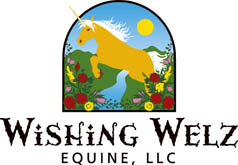Thrush
by Dr. Hiltrud Strasser
Unappetizing, greasy substances in the creases of the frog often lead the horse
owner to suspect thrush. Frequently, this diagnosis will be confirmed by a vet
or farrier on the basis of this symptom. On closer investigation, however, it
turns out that only a small percentage of the hooves with damp frog sulci actually
have thrush.
Sweat glands in the frog sulci provide for a damp climate in the tight folds.
In this way, the elasticity of the frog horn is ensured, and the anaerobic bacteria
which live here (as everywhere in tight folds on mammalian skin) and which suppress
germs, disease and putrefaction, find a suitable environment.
In the confines of the frog sulcus the continually formed horn cannot be worn
away in any other way (so that is does not become ever tighter in the sulcus)
than through decomposition to a fluid mass.
This decomposition is done by the anaerobic bacteria. The acid produced is
well known for preventing rot and putrefaction, which is why we have, from time
immemorial, preserved vegetables in acidic form (pickled cabbage, etc.) A decomposition
of frog horn into an acidic or caseous mass is therefore the natural course
of events in the frog. It is illogical to remove this moist, acidic environment
(with thorough cleansing), because without it, disease and putrefaction can
take hold in this region.
If, however, this decomposition grease does not smell acidic-caseous, but rather
musty-rotten, a high sensitivity in the frog region is also noticeable, even
lameness. In this case we are dealing with thrush.
In most hoof textbooks (Ruthe, Koerber, et al.) poor hoof care and insufficient
stable hygiene are usually cited as causes of thrush. Frequently the blame will
also be given to incessant wetness or dampness. As control measures, desiccating
and disinfecting treatments are advised, in the form of covering bandages, specialized
shoeing, cleansing with iodine-mixtures, etc.
However, many years of studying hooves and investigating successful treatments
of thrush have brought to light another picture of the cause of this disease.
Moisture, at any rate, is not responsible (think of the Camargue horses, which
live for weeks in flooded pastures and retain healthy hooves).
Poor hoof care can only partly be identified as a cause (for example, with horses
kept standing most of the time, unable to move freely), for who looks after
the hooves of the wild, large breeding herds?
The cause of thrush, as with most other hoof problems, lies in reduced circulation
and thus restricted blood supply to the hoof.
Even in the old books on hoofcare, thrush was depicted as a contracted hoof.
In a contracted hoof, the lateral walls are parallel to one another, i.e. they
do not diverge ground ward, as would be the case in a healthy hoof. When a healthy
hoof becomes contracted, the sheets of sole horn are compressed laterally, at
the expense of the frog, which is pinched.
A cross-section through a healthy and a contracted hoof show the changes inside
the hoof. The horn pressure against the transition between sole and frog corium
(where, in the area of the heel, the bars are formed) flattens the corium and
so impedes circulation in the region of the frog sulci. Too little oxygen and
nutrient rich blood reaches the frog corium, and too little horn is produced
in relation to the constant decomposition of the soft horn by bacteria. The
frog becomes weaker and weaker. With dehydration of the hoof, cracks appear
in the thin sheet of soft horn, possibly in as far as the corium, which then
become infected. Wound discharge is a slightly alkaline environment and further
helps the putrefactive agents. Because of the poor blood supply, the corium
cannot heal. The frog region is sensitive to pressure to the point of lameness.
The situation cannot, of course, be improved by drying and immobilization (stall
rest), but rather only by the removal of the cause, i.e. the contraction of
the hooves. The contracted hoof must therefore be brought to a normal, open
shape, in which the frog corium will again be optimally supplied with blood.
It does not help--as is commonly done--to use circulation-enhancing or anti-infectious
agents, intravenously or through the alimentary tract, because they do not reach
the problem area on account of the reduced blood supply.
To achieve the opening of contracted hooves, optimal living conditions for
the horse are necessary (freedom of movement 24 hours/day), as well as frequent,
knowledgeable hoofcare and proper trimming.
It is obvious that thrush can not be healed through shoeing.
Copyright Dr. vet. med. H. Strasser
Blaihofstr. 42/1, 72074 Tuebingen, Germany
Tel/Fax: (011) 49-7071-87572
Ed. & Canadian contact: Sabine Kells at email: textorder @ shaw.ca
©2006 by The Horse's Hoof. All rights reserved. No part of
these publications may be reproduced by any means whatsoever without the written
permission of the publisher and/or authors. The information contained within
these articles is intended for educational purposes only, and not for diagnosing
or medicinally prescribing in any way. Readers are cautioned to seek expert
advice from a qualified health professional before pursuing any form of treatment
on their animals. Opinions expressed herein are those of the authors and do
not necessarily reflect those of the publisher.
